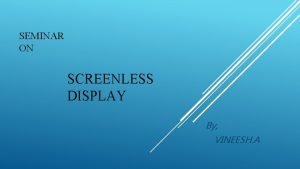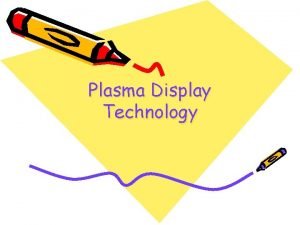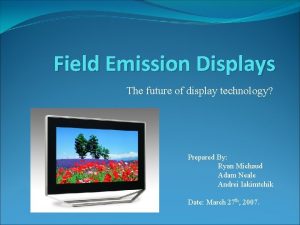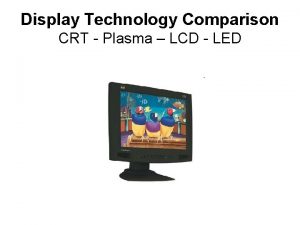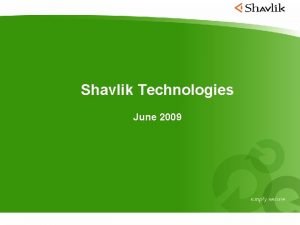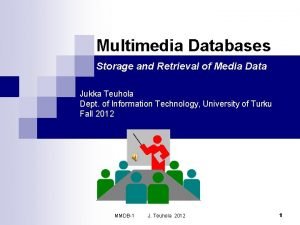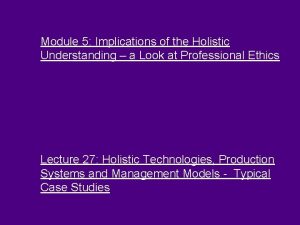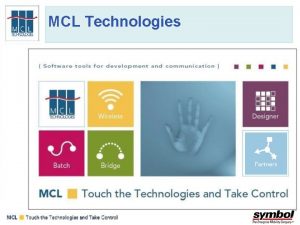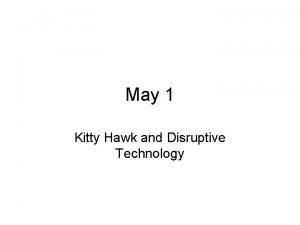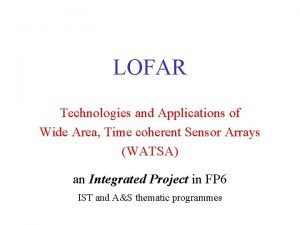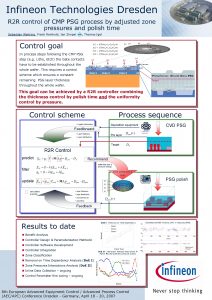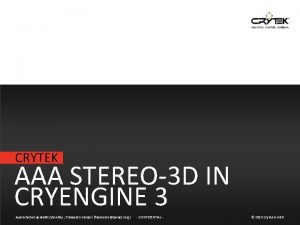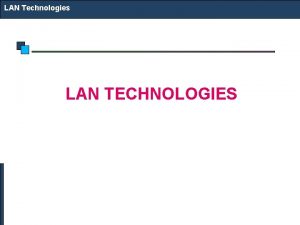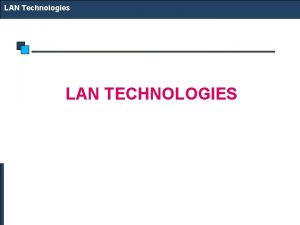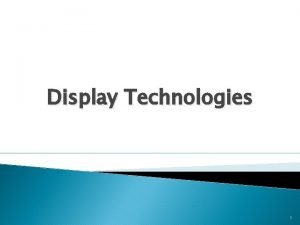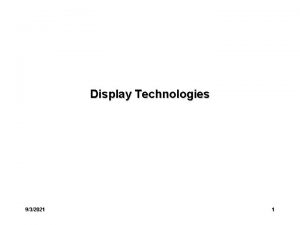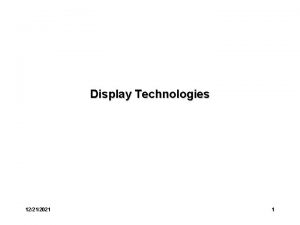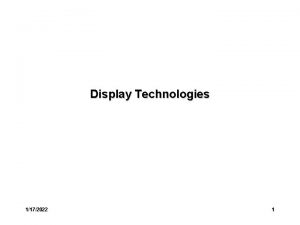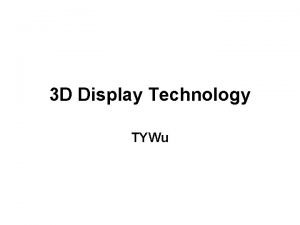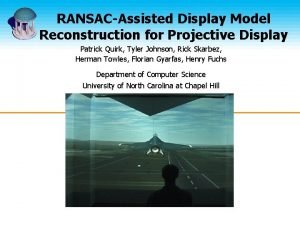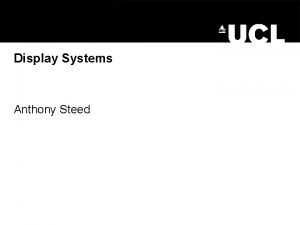Display Technology Stereo3 D Display Technologies David F








































- Slides: 40

Display Technology: Stereo&3 D Display Technologies David F. Mc. Allister Department of Computer Science North Carolina State University Raleigh, NC 27695 -8206 Tel: 919 -233 -8164 Fax: 919 -233 -8578 Email: david@cmonline. com 20/10/2004 copyright@Jung, Bily, Jingjing

Recently there have been rapid advancements in 3 D techniques and technologies. Old techniques have been improved, and new ones have been developed. Our brain integrates these two images into one threedimensional picture. 20/10/2004 copyright@Jung, Bily, Jingjing

Overview Introduction Depth Cues Physiological Depth Cues Psychological Depth Cues A Technology Taxonomy Stereo Pairs Display Technology Overview Separating Left and Right Eye Views Cross Talk Field Sequential Techniques Time-Parallel Techniques 20/10/2004 copyright@Jung, Bily, Jingjing

<Depth cues> Physiological depth cues Psychological depth cues Accommodation (short viewing distances) Process of lens changing shape < Taxonomy > < Stereo Pairs > Convergence (short viewing distances) Inward rotation of eyes Binocular disparity (medium viewing distances) Difference in the images projected on the left and right eye retinas Motion parallax Different view of a scene in response to movement 20/10/2004 copyright@Jung, Bily, Jingjing

http: //info. geography. siu. edu/people/oyana/Teaching/485_551/5 th_lecture. htm 20/10/2004 copyright@Jung, Bily, Jingjing single-image random dot stereograms created by Peter Chang and Gareth Richards in England

<Depth cues> Physiological depth cues Psychological depth cues < Taxonomy > < Stereo Pairs > Linear perspective 20/10/2004 Shading and shadowing copyright@Jung, Bily, Jingjing

<Depth cues> Physiological depth cues Psychological depth cues < Taxonomy > < Stereo Pairs > Aerial perspective 20/10/2004 Interposition copyright@Jung, Bily, Jingjing

<Depth cues> Physiological depth cues Psychological depth cues < Taxonomy > < Stereo Pairs > Retinal image size 20/10/2004 Color Texture gradient copyright@Jung, Bily, Jingjing

<Depth cues> Physiological depth cues Psychological depth cues < Taxonomy > Stereo pair Holographic Multiplanar (Volumetric) 20/10/2004 copyright@Jung, Bily, Jingjing

<Depth cues> Physiological depth cues Psychological depth cues < Taxonomy > Stereo Pairs 20/10/2004 copyright@Jung, Bily, Jingjing

Stereo Pairs Horizontal disparity Left Image+ Right Image=Spatial Images Two interleaved images unite as one. 20/10/2004 copyright@Jung, Bily, Jingjing

Correct <Depth cues> Physiological depth cues Psychological depth cues < Taxonomy > < Stereo Pairs > Vertical disparity Incorrect 20/10/2004 copyright@Jung, Bily, Jingjing

Introduction Depth Cues Physiological Depth Cues Psychological Depth Cues A Technology Taxonomy Stereo Pairs Display Technology Overview Separating Left and Right Eye Views Cross Talk • Cross talk is when Field Sequential Techniques left images reach Time-Parallel Techniques right eye, and right images reach left eye 20/10/2004 copyright@Jung, Bily, Jingjing

<Display Technologies Overview> Field Sequential Time-Parallel Techniques • Images are presented alternately • Most common techniques is shutter glass stereo • Takes advantage of persistence of vision • Frame rate must be very high 20/10/2004 copyright@Jung, Bily, Jingjing

<Display Technologies Overview> Field Sequential Techniques • Time-Parallel Techniques Both views are presented simultaneously • • Dual viewing: Anaglyph (red/green) glasses Polarised glasses Main issue is cross—talk • Separate viewing: • Head--mounted displays 20/10/2004 copyright@Jung, Bily, Jingjing

Overview 3 D Displays: Viewing Devices Required Field Sequential Devices Crystal. Eyes ZScreen system Pulfrich Technique Fake. Space PUSH Display Work Bench Displays VREX Micropolarizers Large Format Displays IMAX Fakespace Systems Displays The Vision. Dome 20/10/2004 copyright@Jung, Bily, Jingjing

• Glasses: • LCD ‘shutter’ or active stereo (most systems)---e. g. Crystal. Eyes • LCD display technology • Two crossed, polarized layers per eye • One permanently polarized • One switchable • Controlled by an IR signal • Cross polarized or ‘passive’ stereo (e. g. IMAX / ZSreen glasses) • two lenses • Polarized in orthogonal directions • Two projectors produce different images --Polarize with filters 20/10/2004 copyright@Jung, Bily, Jingjing

Field Sequential Devices • What is a Crystal. Eyes like? • What is it? Crystal. Eyes ZScreen system One kind of stereo shutter glasses, using active glass system Pulfrich Technique • How does it work? • • Creates illusion of stereo by alternating left and right eye iimages between frames Glasses alternately block out each eye so that each eye sees every other image Requires very high refresh rates Currently used for many systems including CAVE • Property • A high dynamic range----ensure that only the correct image is shown to each eye. Not suffer from ghosting and double-images result • • Fake. Space PUSH Display Work Bench Displays VREX Micropolarizers merit Disadvantages Display system must have a very high frame rate Glasses must have some power supply so batteries or wires are required 20/10/2004 copyright@Jung, Bily, Jingjing

<Depth cues> Physiological depth cues • What is it? • • Passive glass system Polarized glasses ZScreen system • How does it work Pulfrich Technique Fake. Space PUSH Display • Property • • • Advantages: don’t need as quick of a refresh rate as you do with shutter glasses cheap an require no power supply Disavantages: low dynamic range, may suffer from ghosting or image cross talk. Work Bench Displays VREX Micropolarizers • Solution to prevent ghosting • electrode-segmentation------increasing the effective dynamic range of the system and produces a high quality stereo image 20/10/2004 copyright@Jung, Bily, Jingjing

Ploarized glasses • Cheap • Light and comfortable Shutters vs polarization • Expensive( ~$250+) • More or less indestructible • One display(Screen or projector) • Continuous image in both eyes • Heavier and more uncomfortable (2 projectors) • Two projectors---alignment issues • Non-polarizing screen required --Batteries and electronics inside • Batteries run out – maintenance issues • 50% light loss • Much more fragile • Can’t tilt your head more than a few • 50% light loss 20/10/2004 Degrees ---could avoid with two active layers copyright@Jung, Bily, Jingjing

• Pulfrich Effect • • Crystal. Eyes This effect is called Pulfrich-effect in honor of the german physicist Carl Pulfrich (1858 -1927). ZScreen system When viewing a moving image, the user can see two different images if a filter is placed over one eye Usually a neutral-density filter Fakespace push Also works with sunglasses with one display lens removed Work Bench The perception in the covered eye is slowed, thus that Displays eye sees an older image If the images are created correctly(for example, rotating the scene about a vertical axis), the current image and the VREX delayed image will form a stereo pair Micropolarizers Cheap and capable of being broadcast, but requires constant motion Pulfrich Technique • • • Pulfrich-Glasses Field Sequential Devices The darkened eye reacts slower to optical stimuli. It's based on a time-parallax in horizontally moving objects. The parallax is determined by the speed of movement. In case the movement 20/10/2004 stops the image turns 2 D. copyright@Jung, Bily, Jingjing

Field Sequential Devices Crystal. Eyes ZScreen system Pulfrich Technique Fakespace push display Work Bench Displays VREX Micropolarizers • How does it work? • using a box shaped binocular viewing device with attached handles which is mounted on a triad of cylindrical sensors. 20/10/2004 copyright@Jung, Bily, Jingjing

• • • ‘Workbench’ Field Sequential Devices Crystal. Eyes Similar to a wall display Tiltable ZScreen system Possibly can be made flat Pulfrich Technique Usually used with tracking Usually used by one person Fakespace push display Used as a wide screen monitor Using active glasses stereo technique Work Bench User has very little room to move around Displays Field of regard is small Fake. Space Immersa. Desk A “portable” semi-immersive environment: VREX Micropolarizers VR ‘Responsive’Workbench Fakespace Immersa. Des M 1 20/10/2004 Fakespace Immersa. Desk R 2 copyright@Jung, Bily, Jingjing

Field Sequential Devices • What is it? • an optical device that can change the polarization of an LCD display on a line by line basis. • How does it work Crystal. Eyes ZScreen system Pulfrich Technique Fakespace push display • A periodic array of microscopically small Work Bench Displays polarizers that spatially alternate VREX between mutually perpendicular Micropolarizers polarizing states. • Passive polarized glasses are needed to view the image • Requiring a single-frame stereoscopic image format combining a left-eye perspective view with a right-eye perspective view to form as composite image, which contains both left and righteye information alternating on a line-byline basis. 20/10/2004 copyright@Jung, Bily, Jingjing

• How does it work when projecting stereo, IMAX uses the standard field sequential polarized projection mechanism where the user wears passive glasses. • allow multiple users IMAX SCREEN IMAX PROJECTOR 20/10/2004 <Large Format Displays> IMAX Fakespace Systems Displays The Vision Dome copyright@Jung, Bily, Jingjing

<Large Format Displays> • • One kind of immersive technology a Extension of flat screen stereo—Cave Small room theatre Back-projected screens: walls, Floor, Ceiling required active shuttering glasses • Any combination from 2 -6 sides of box • Designed to avoid HMD(Head Mouted Device) limitations on update rate IMAX Fakespace Systems Displays The Vision Dome • 4 -sided Cave • UCL’s Cave 20/10/2004 • 4 -sided CAVE in UNIMAS VR Lab, Kota Samarahan, Sarawak copyright@Jung, Bily, Jingjing

<Large Format Displays> • • When the idea of a CAVE was conceived, it was originally supposed to be 6 -sided CAVE – – IMAX Fakespace Systems Displays The Vision Dome 2. 5 m x 2. 5 m Back projektion Aktive stereo 1 person with tracking, + a few observers without tracking 20/10/2004 copyright@Jung, Bily, Jingjing

<Large Format Displays> • • • A another Extension of flat screen stereo—Geo. Wall The Geo. Wall created to be a cheap and portable alternative to the CAVE Uses two projectors and polarized light glasses (passive glasses system) Can be used for an entire classroom full of people 20/10/2004 IMAX Fakespace Systems Displays The Vision Dome copyright@Jung, Bily, Jingjing

<Large Format Displays> IMAX Fakespace Systems Displays The Vision Dome Distorted images • What is it? Multiple projector system Project onto domed surface overhe-ad Can cover as much as 180 or more 180*180 ---Hayden Planetarium (Trimension) Using distorted images: 20/10/2004 • How the environments looks in it? copyright@Jung, Bily, Jingjing

Overview Autostreoscopic Displays Alternating Pairs Moving Slit Parallax Barrier The DTI System Seaphone Display The Sanyo Display The Hines. Lab Display Volumetric Displays 20/10/2004 Oscillating Plane Mirror Varifocal Mirror Rotating Mirror copyright@Jung, Bily, Jingjing

Autostreoscopic Displays Alternating Pairs Moving Slit Parallax Barrier The DTI System Seaphone Display The Sanyo Display The Hines. Lab Display Oscillating Plane Mirror Varifocal Mirror Rotating Mirror 20/10/2004 Figure 1 VISIDEP copyright@Jung, Bily, Jingjing

Autostreoscopic Displays Moving Slit Parallax Barrier Alternating Pairs Moving Slit Parallax Barrier The DTI System - A mechanical moving slit display - Popularized by Homer Tilton Seaphone Display The Sanyo Display The Hines. Lab Display - Parallactiscope - No commercially viable products 20/10/2004 Oscillating Plane Mirror Varifocal Mirror Rotating Mirror copyright@Jung, Bily, Jingjing

Autostreoscopic Displays The DTI System Alternating Pairs Moving Slit Parallax Barrier The DTI System Seaphone Display The Sanyo Display The Hines. Lab Display Figure 2 Figure 3 From above Oscillating Plane Mirror Varifocal Mirror Rotating Mirror - Each stereoscopic image is half the full resolution of the screen -The stereoscopic display is quite sensitive to the position of the viewer’s head 20/10/2004 copyright@Jung, Bily, Jingjing

Autostreoscopic Displays Seaphone Display Alternating Pairs Moving Slit Parallax Barrier The DTI System Seaphone Display The Sanyo Display The Hines. Lab Display Oscillating Plane Mirror Varifocal Mirror Figure 4 Rotating Mirror - A right eye system, a left eye system and head tracking system - The stereo viewing area determines the number of viewers 20/10/2004 copyright@Jung, Bily, Jingjing

Autostreoscopic Displays Seaphone Display Alternating Pairs Moving Slit Parallax Barrier The DTI System Seaphone Display The Sanyo Display Figure 5 The Hines. Lab Display Oscillating Plane Mirror Varifocal Mirror Rotating Mirror 20/10/2004 copyright@Jung, Bily, Jingjing

Autostreoscopic Displays The Sanyo Display Alternating Pairs -Use LC technology Moving Slit Parallax Barrier The DTI System -Head tracking System Seaphone Display The Sanyo Display -Use two image splitter - No ghosting The Hines. Lab Display Oscillating Plane Mirror Varifocal Mirror Rotating Mirror 20/10/2004 copyright@Jung, Bily, Jingjing

Autostreoscopic Displays The Hines. Lab Display Alternating Pairs Moving Slit Parallax Barrier The DTI System Seaphone Display The Sanyo Display Figure 6 The Hines. Lab Display Oscillating Plane Mirror Varifocal Mirror Rotating Mirror 20/10/2004 copyright@Jung, Bily, Jingjing

Volumetric Display Oscillating Plane Mirror Alternating Pairs Moving Slit Parallax Barrier - No disconnection of accommodation The DTI System Seaphone Display - All depth cues would be consistent The Sanyo Display - According to the focal length of The mirror, dramatic improvement in view volume depth can be obtained. The Hines. Lab Display Oscillating Plane Mirror Varifocal Mirror Rotating Mirror 20/10/2004 copyright@Jung, Bily, Jingjing

Volumetric Display Varifocal Mirror Alternating Pairs Moving Slit Parallax Barrier The DTI System - A commercial multiplanar - Use a flexible circular mirror anchored at the edges. Seaphone Display The Sanyo Display The Hines. Lab Display Oscillating Plane Mirror Varifocal Mirror Rotating Mirror 20/10/2004 copyright@Jung, Bily, Jingjing

Volumetric Display Rotating Mirror Alternating Pairs Moving Slit Parallax Barrier -Use RGB lasers for point plotting and a double helix mirror rotating at 600 rpm as reflecting device The DTI System Seaphone Display The Sanyo Display The Hines. Lab Display Oscillating Plane Mirror Varifocal Mirror Rotating Mirror 20/10/2004 copyright@Jung, Bily, Jingjing
 Refresh crt consist of
Refresh crt consist of Random scan display
Random scan display Raster scan display and vector scan display
Raster scan display and vector scan display E commerce architecture and technologies in web technology
E commerce architecture and technologies in web technology Seminar on screenless display
Seminar on screenless display Plasma display technology
Plasma display technology History of display technology
History of display technology Plasma vs crt
Plasma vs crt Crt display technology
Crt display technology Digital differential analyzer algorithm
Digital differential analyzer algorithm Waites sensor technologies
Waites sensor technologies Emergent game technologies
Emergent game technologies Krisent technology
Krisent technology Mobilean technologies
Mobilean technologies Wan technologies
Wan technologies Wan devices
Wan devices Drama study design
Drama study design Tesca technologies pvt. ltd
Tesca technologies pvt. ltd Stiesdal storage technologies a/s
Stiesdal storage technologies a/s Langenburg water
Langenburg water Spine technologies (i) pvt. ltd
Spine technologies (i) pvt. ltd Sirena technologies
Sirena technologies Genex turbine
Genex turbine Shavlik technologies
Shavlik technologies Savex technologies
Savex technologies Qhr technologies inc
Qhr technologies inc Hydrogen production from biomass ppt
Hydrogen production from biomass ppt Orm technologies
Orm technologies Sisoft technologies
Sisoft technologies Aim lans
Aim lans Abb network management
Abb network management Nec technologies noida address
Nec technologies noida address Storage and retrieval technologies in multimedia
Storage and retrieval technologies in multimedia Holistic technology in human values
Holistic technology in human values Mcl technologies
Mcl technologies Kitty hawk technologies
Kitty hawk technologies Lyceum of information technologies
Lyceum of information technologies Lucent technologies bell labs
Lucent technologies bell labs Lofar technologies
Lofar technologies Introduction to wan
Introduction to wan Infineon technologies dresden
Infineon technologies dresden




